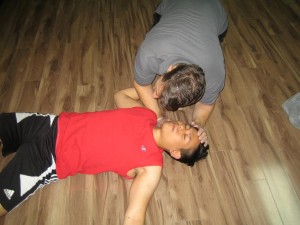Overview
Assessing the victim is the primary step in performing first aid. Before you know what sort of care you need to provide, you must first decide exactly what is wrong with the causality. Apply these steps to evaluate the casualty:
Evaluating a Conscious Casualty:
- Approach the casualty, and tell causality not to move. Introduce yourself, and enquire if you can be of assistance.

Assessing the victim is the primary step in performing first aid. Before you know what sort of care you need to provide, you must first decide exactly what is wrong with the causality. - If casualty says “yes,” ask what occurred, if the causality is having an issue with their breathing, and if and where they are experiencing any pain. Based on the answers, decide if EMS should be called. If uncertain, phone for EMS.
- Examine victim’s head, neck, legs, arms, stomach, and chest for injuries. Look for blood loss, bruising, inflammation, or other noticeable injuries. Feel for any bumps or abnormalities on the legs or arms, but DO NOT move any part that is sore. Be certain to tell the casualty what you are going to do before you do it.
- If you think there is a back or neck injury, DO NOT shift the causality or allow them to move. If no neck or back injury is assumed, have the causality rest in a place that is comfy for them. If the causality is bleeding, place pressure to control the bleeding.
- Monitor the casualty’s breathing, and stay with them until EMS shows up.
Evaluating an Unconscious Causality:
- Approach the casualty, lightly tap the casualty’s shoulder, and ask if they are fine. If the casualty responds, apply the steps for a conscious casualty.
- If no reply and casualty is an adult, phone for the EMS. If the casualty is a child, provide care for one minute prior to calling for EMS. If somebody else is near, have them phone for EMS.
- Check airway, breathing, and circulation (ABC’s).
- Look for any signs of bleeding.
- If no back or neck injury is assumed, place the casualty in the Recovery Position.
